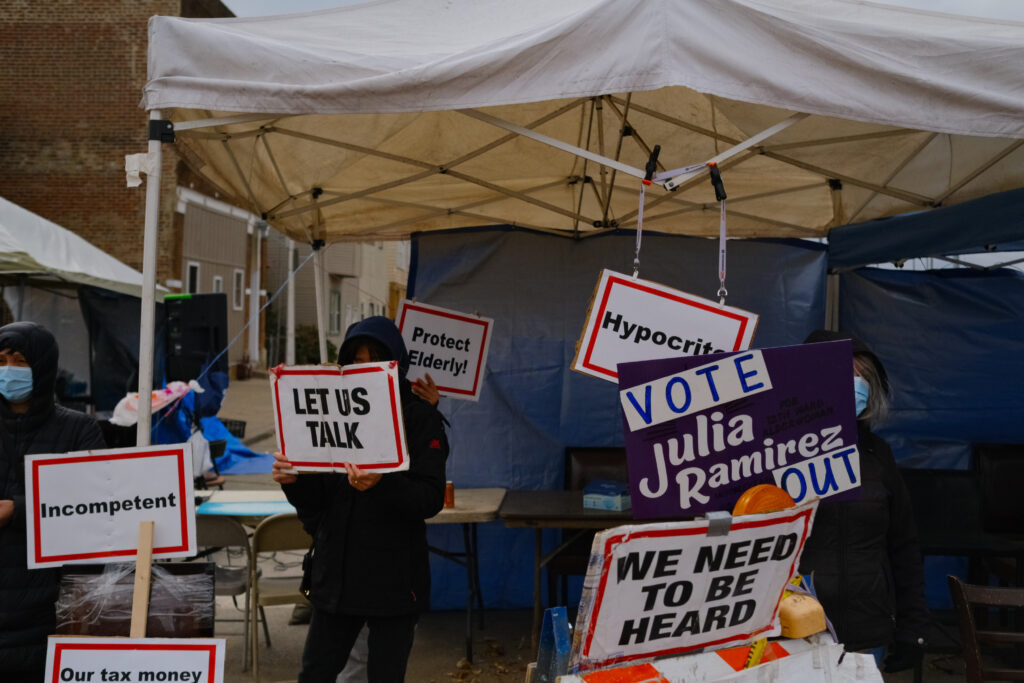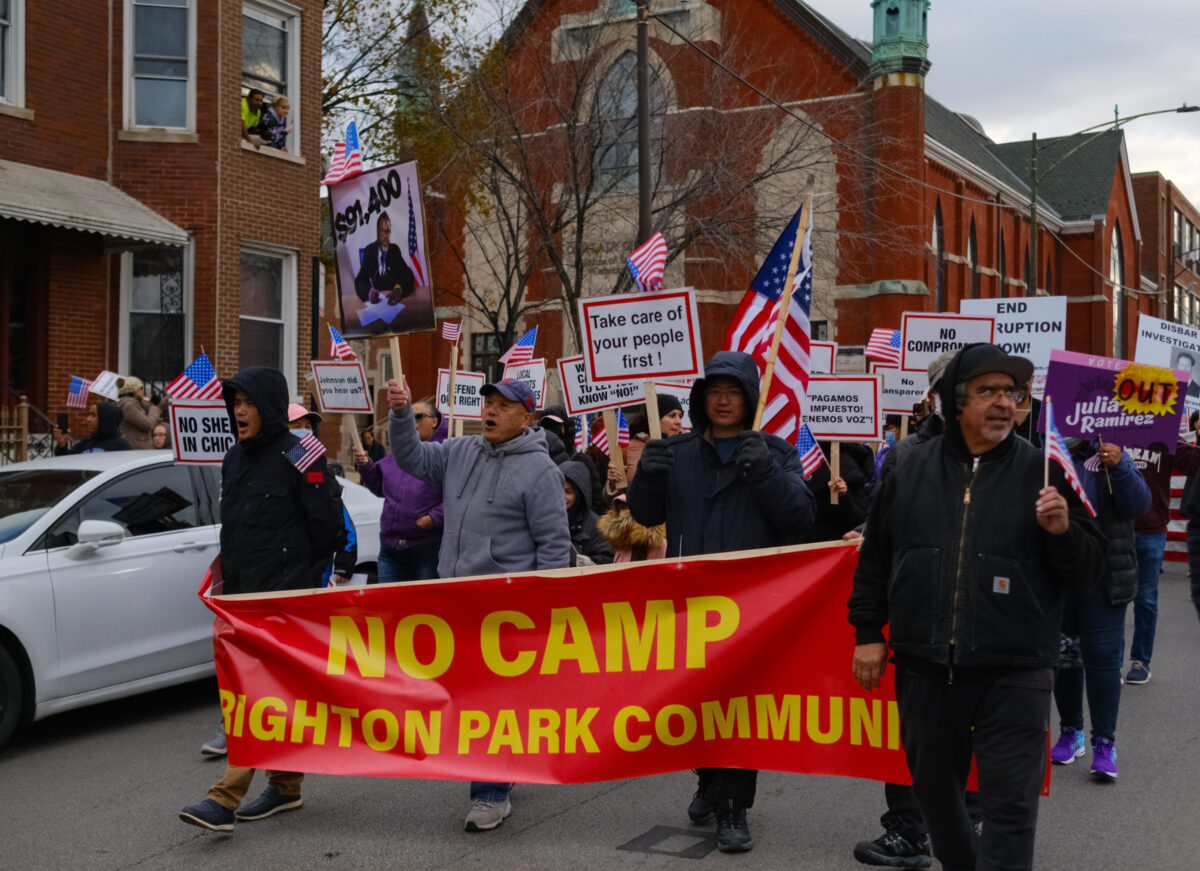The Johnson administration’s announcement to construct a winterized base camp in a Brighton Park industrial lot has sparked ongoing protests from residents in the neighborhood, which resulted in an attack on Alderperson Julia Ramirez on October 19 after a brief community meeting.
Jacquelyn Zuniga, the organizer of the multiracial protest on the 19th, told the Chicago Sun-Times that due to language barriers it was difficult to de-escalate the conflict after protesters ambushed Ramirez. Many of those confronting the alder were holding protest signs written in Chinese characters.
Recent clashes between Chicagoans and city officials are drawing a demographic not often seen in public displays of protest—Chicagoans of Chinese descent. As a consistent lack of affordable housing over the past decade pushes Chinese residents out of Chinatown and into neighborhoods further southwest, longstanding frustrations over decreased property values and lack of political representation are boiling to the surface.
South Side Chinese residents are an emerging voice in city politics and community organizers emphasize the importance of language justice to support healthy civic engagement.
According to a 2023 community data report by the Chicago Metropolitan Agency for Planning, the Asian American population in Brighton Park has grown from 2.9 to 9.9 percent between 2000 and 2021. Many of these new residents come from the Chinese community centered around the cultural hub of Chinatown.
COVID-19 rapidly displaced low-income Chinese Americans from their longtime residences in the Chinatown area due to a loss of jobs and inability to pay rents, according to data provided by the Chinese American Service League (CASL). Paul Luu, the CEO of CASL, recently corroborated this trend, referencing U.S. Census Data, in an opinion piece in the Sun-Times.
“Nearly 30 percent of Asians 60 and older in the Bridgeport, McKinley Park, and Chinatown/Armour Square Areas live in poverty,” he wrote.
The piece goes on to add that the current waitlist for senior housing is so long that some folks pass away before being able to access a unit, and called on the government to provide more affordable housing solutions to the Chinese-American community.
Would-be homeowners also wrestle with finding affordable housing close to Chinatown. When asked whether affordable housing contributed to his decision to live in Brighton Park, Michael Lin, a Chinese resident who has been actively protesting the encampments, said, “Yeah, the housing price is relatively cheaper than the North Side, the West Side, and even the downtown area.”
He said that before he decided to settle in Brighton Park, he also looked for housing in Bridgeport and on the North Side. According to Redfin, the median prices for housing is $390,000 in Bridgeport and $438,000 in Armour Square. In Brighton Park, on the other hand, the median price is almost half at $265,000.
The desire for safe, stable housing is what connects the protesters in Brighton Park with the migrants seeking refuge. Deputy Mayor for Immigrant, Migrant and Refugee Rights Beatriz Ponce De Leon said that capacity for the encampments will begin at five hundred, but can expand to accommodate up to two thousand people.
Lin said that he isn’t opposed to housing migrants in Brighton Park, but expressed concerns about the high concentration. “If we only take two hundred, maybe we’re not that much concerned, but two thousand is different,” he said.
“If you asked [Chinese] people what the top three concerns are, the number one concern would be overwhelmingly safety,” said Grace Chan McKibben, the executive director of the Coalition for a Better Chinese American Community (CBCAC). CBCAC is a coalition that offers resources for the Chinese community through civic education and issue advocacy, among other things.
The climate of xenophobia during the COVID-19 pandemic accelerated Asian-American concerns about public safety. The Guardian reported that Stop Asian Hate, a national anti-Asian discrimination coalition, documented over 9,000 reports of incidents from 2020 to 2021. The same report showed that the Center for the Study of Hate and Extremism found a 339 percent increase in hate crimes against Asian Americans. There were no reports of hate crimes in the Chinese community in Chicago, but incidences of violent crime reported during the pandemic increased paranoia. Public safety became an urgent concern, and one of the main issues that propelled Nicole Lee to victory in the 11th ward alderperson election.
David Li, a policy officer at CASL, told the Weekly that feelings of neighborhood safety dropped significantly from 2020 to 2021 based on their Social Determinants of Health (SDH) report—a report that drew participants from Bridgeport, Armour Square, Brighton Park, and McKinley Park. The overall percentage of respondents who reported feeling safe dropped from 70.7 to 54.5, even though reported incidents of violent crime had actually decreased overall from 2020 to 2021, according to Chicago Police Department data.
McKibben explains that what constitutes neighborhood safety for Chinese Americans often means to live in a neighborhood with racial or ethnic similarities, a tendency that has itself left Chinatown residents open to charges of racism and xenophobia. “The average Chinese American or Chinese immigrant probably does feel safer if there are more Chinese people around, mostly because that’s what they are familiar with,” said McKibben.
Feelings of political disenfranchisement among the Chinese protestors are strong and are exacerbated by significant English-language barriers.
Many Chinese public commenters at the October 24th Kelly High School community meeting were angry that they were not consulted about the migrant camps in Brighton Park. “Although this meeting was planned earlier, extensive construction had begun two weeks ago,” said Sonya Zu, one of the many commenters. “What’s the point of having a hearing if you’re going to do whatever you want?”
Armour Square, where Chinatown is located, has been a majority-Asian neighborhood for more than thirty years now and as of the 2020 Census so is Bridgeport, as the number of Asian residents has surpassed that of the neighborhood’s traditionally white base. Many of these new residents are Chinese.

However, a majority Chinese American voting bloc did not emerge until 2023, when in the wake of a remap of the 11th Ward, Nicole Lee officially won the aldermanic seat over Anthony Ciaravino. With Lee’s election came stronger advocacy for resources for the Chinese-American community, such as Lee’s call for greater inclusion in the city’s affordable housing plans.
A majority voting bloc bolsters the chances of political representation, but historically low Asian voter turnout shows that there might be other barriers to entry into the political process.
McKibben said that language accessibility often keeps Chinese Americans from civic engagement. “I think language justice is key. The concept of language justice versus language access is that language access is creating ways for you to understand the information, possibly through translation. Language justice is honoring the fact that you may prefer to use Chinese or Spanish because that’s how you feel the most comfortable, better understood, and better empowered,” she said.
She has been advocating for language justice in Chicago since 2003 and has been active in supporting the Language Equity and Access Act currently on the Senate floor. A study by Asian Americans Advancing Justice shows that even though Section 203 of the Voting Rights Act is meant to close the language barrier by offering translated material, other accessibility issues often occur, confirming that more needs to be done around language justice beyond translation at the polls.
McKibben said that language barriers directly contribute to Chinese residents’ reliance on WeChat, a Chinese messaging and social media application, as a source of information, because the need for translation becomes a non-issue.
But the communication platform is also a hotbed for misinformation and disinformation. For example, right-wing extremists spread lies on the platform about riots and military presence at voting sites to scare Chinese Americans out of going to the polls in the 2020 presidential election.
The lack of both language proficiency and the resources to bring about language justice pervades the everyday lives of the average Chinese American, making political disenfranchisement less of a feeling and more of a condition of life.
“In 2019, thirteen percent of Asian people who did not speak English very well, according to proficiency standards, hindered the ability to understand and engage complicated homebuying processes,” Li said. He went on to detail how this contributes to subpar utilities, faulty pipes, and other infrastructural elements, such as protection from weather flooding and stable heating systems, that greatly affect one’s quality of housing and can ripple out to other forms of unhealthy living standards.
Even though the election of the first Chinese-American alderperson in Chicago’s history is a victory for the larger Chinese community, many in Brighton Park still stand on the outside looking in. Despite protests and without consultation with Ald. Ramirez, on November 1 the city went forth to finalize a land use contract to build the tent camp with Barnacres Corporation, the owner of the lot on 38th and California, effectively disregarding many community concerns. The contract stated that the city will pay $91,400 a month to Barnacres for use of the land for an initial time period of six months, with allowance for extensions at a three-percent increase.
When asked whether he feels like their voices are being heard, Lin said, “I don’t think so. They’re not doing anything to help us right now.”
However, the fact of the encampment protests does demonstrate a growing sense of community belonging.
Lin said that this was the first protest he’s ever participated in. When asked whether he has felt closer to his neighbors, he said, “Yeah. We feel like we are all on the same page. We all feel the same thing.” Those protesting the tent encampments consist not only of Chinese residents, but Black and Latinx folks as well.
Many attendees at the Kelly meeting agreed that building encampments on an industrial lot is not a sufficient housing solution for anyone. Across all demographics, voices were unified in expressing the right to adequate and safe housing for the migrants seeking refuge.
McKibben says, “Interracial solidarity is always a difficult one because Chicago has historically been such a racially segregated city… There is a perceived fight for resources.” Despite these systemic forces, the Brighton Park protests show that residents across racial lines are finding solidarity in a common struggle.
Other voices in the community are calling them to go a step further by identifying connections with the migrants in need of refuge. “I’d just like to warn us against this culture of fear because it has been used against Black communities, Asian communities, Muslims, as a political tactic,” said Jessica Suarez Nieto, who joined in a chorus of voices that appealed to the community’s common humanity that evening.
Kevin Hu is a multidisciplinary writer, tech worker, and a recent Chicago re-transplant. You can find more of their writing at www.kevinhu.dev.

